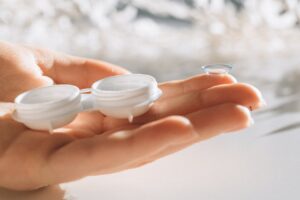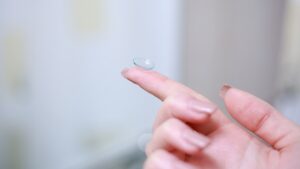Are You Hydrating Your Lenses Right?
Are your eyes scratchy and irritated after a long day of wearing contact lenses? Before you blame it on dry eyes, consider this: could your contacts simply be dehydrated? We all know the importance of staying hydrated, but what about our trusty lenses? In this article, we’ll dive into rehydrating contacts, exploring why it’s crucial, how to do it right, and what happens when we neglect this essential step in our eye care routine. So, grab your solution and join us on this journey to keep your vision clear and comfortable.
Overview
As we embark on this journey to understand the intricacies of rehydrating contacts, let’s first delve into the fundamental concepts surrounding this essential aspect of eye care. Picture this: your eyes are the windows to your soul, but what about the lenses that enhance your vision? Like a well-oiled machine, contact lenses require proper maintenance to function optimally.
- The Role of Hydration: At the core of contact lens care is hydration’s crucial element. Much like our bodies need water to thrive, contact lenses rely on moisture to maintain their shape, comfort, and clarity. Lenses can become stiff, brittle, and uncomfortable to wear without adequate hydration.
- Understanding Dehydration: Dehydration isn’t just a concern for our bodies; it’s also a significant issue for contact lenses; when lenses lose moisture, they become dehydrated, leading to many problems such as reduced oxygen permeability, protein buildup, and increased friction on the cornea. These issues not only compromise comfort but also pose risks to ocular health.
- Common Causes of Dehydration: Several factors contribute to contact lens dehydration. Environmental conditions such as low humidity levels, exposure to smoke or dust, and prolonged screen time can accelerate moisture loss. Improper lens care practices, including wearing lenses beyond their recommended lifespan or using expired solutions, can also exacerbate dehydration.
- Signs and Symptoms: How do you know if your contacts are dehydrated? Look for telltale signs such as dryness, irritation, redness, and blurred vision. These symptoms may worsen throughout the day, especially in challenging environments like air-conditioned offices or windy outdoor settings.
- Importance of Rehydration: Rehydrating contacts isn’t just about restoring moisture; it’s about revitalizing their performance and preserving ocular health. By replenishing moisture levels, you can enhance comfort, extend lens wear time, and reduce the risk of complications such as dry eye syndrome and corneal abrasions.
- Methods of Rehydration: Fortunately, rehydrating contacts is a straightforward process. From using rewetting drops and saline solutions to employing overnight conditioning systems and hydrogen peroxide-based cleaners, various methods are available to revive your lenses and ensure a refreshing wearing experience.
Understanding Dehydration
Now that we’ve established the importance of hydration in contact lens care let’s explore the intricate process of dehydration and its implications for ocular health. Think of dehydration as a silent adversary, stealthily robbing your lenses of vitality and leaving your eyes vulnerable to discomfort and complications.
The Dehydration Dilemma: Dehydration, in the context of contact lenses, occurs when these delicate ocular accessories lose moisture, causing them to shrink, stiffen, and lose their suppleness. This phenomenon resembles a withering flower devoid of the life-giving sustenance it needs to flourish.
Factors Fueling Dehydration: A myriad of factors can fuel the dehydration of contact lenses, ranging from environmental influences to personal habits. Low humidity levels, exposure to dry or dusty conditions, and prolonged wear time contribute to moisture loss. Additionally, improper lens care practices, such as using tap water or saliva to clean lenses, can introduce contaminants and hasten dehydration.
Consequences of Dehydration: The consequences of lens dehydration extend beyond mere discomfort; they pose significant risks to ocular health. When lenses lack sufficient moisture, they become more prone to protein deposits, lipid accumulation, and microbial growth. This compromises visual acuity and increases the likelihood of developing conditions such as keratitis and corneal ulcers.
Recognizing the Signs: How can you tell if your contacts are dehydrated? Look for subtle signs such as increased lens awareness, decreased wearing time, and fluctuating vision quality. Symptoms may vary from mild dryness and irritation to severe redness and inflammation, necessitating prompt intervention to prevent further complications.
Table: Common Signs of Contact Lens Dehydration
| Signs of Dehydration | Description |
| Dryness | The sensation of dryness or roughness on the surface of the lens |
| Blurred Vision | Reduced clarity of vision, especially during prolonged wear |
| Irritation | Persistent discomfort, itching, or burning sensation in the eyes |
| Redness | The appearance of red or bloodshot eyes, particularly towards the end of the day |
| Reduced Comfort | Increased awareness of lenses, discomfort, or feeling of foreign body presence in the eyes |
Strategies for Rehydration
Now that we’ve uncovered the nuances of contact lens dehydration, it’s time to equip you with practical strategies to combat this common concern and revitalize your lenses. From simple lifestyle adjustments to specialized products, myriad approaches to rehydration are waiting at your disposal.
- Hydration Habits: Start cultivating good hydration habits internally and externally. Drink plenty of water throughout the day to ensure your body stays well-hydrated, which indirectly benefits the moisture levels of your eyes and lenses. Additionally, consider using lubricating eye drops or artificial tears to provide instant relief and hydration to dry, tired eyes. If you are wondering about the differences between eye drops and contact lens solution, please read this blog post.
- Proper Lens Care: Proper lens care practices are the foundation of adequate rehydration. Ensure you follow the cleaning and disinfection regimen your eye care professional recommends. Use only approved contact lens solutions and avoid shortcuts such as rinsing lenses with tap water, which can introduce contaminants and exacerbate dehydration.
- Rewetting Drops: Invest in high-quality rewetting drops specifically formulated for contact lenses. These lubricating drops mimic the eye’s natural tears, providing instant relief from dryness and discomfort. Keep a bottle handy throughout the day for quick and convenient rehydration whenever your eyes need a boost.
- Overnight Conditioning: Consider incorporating overnight conditioning systems into your lens care routine. These specialized solutions work overnight to rehydrate and rejuvenate lenses, ensuring they’re fresh and comfortable to wear the next day. Simply soak your lenses in the conditioning solution overnight for enhanced moisture retention and extended wear time.
- Hydrogen Peroxide Systems: For those seeking a more intensive rehydration method, hydrogen peroxide-based cleaning systems offer an effective solution. These systems use a two-step process to clean and disinfect lenses while neutralizing harmful microorganisms. The final step involves neutralization, converting the hydrogen peroxide into water and oxygen, leaving your lenses thoroughly hydrated and ready for wear.
- Silicone Hydrogel Lenses: Consider switching to silicone hydrogel lenses, renowned for their enhanced moisture retention properties. These advanced materials allow for excellent oxygen permeability and moisture retention, reducing the risk of dehydration and promoting long-term ocular health.
Frequently Asked Questions (FAQs)

As we navigate the world of contact lens rehydration, it’s natural to have questions about best practices, potential pitfalls, and everything in between. Here are some common queries answered to provide clarity and confidence in your lens care routine:
Why do my contact lenses feel dry, even when I’ve just put them in?
Your lenses may be experiencing initial dehydration due to insufficient moisture content or improper handling during insertion. Try rewetting drops to provide instant relief and hydration.
Can I use water to rehydrate my contact lenses in a pinch?
No, using water to rehydrate contact lenses is not recommended as it can introduce harmful microorganisms and contaminants, leading to eye infections and complications. Stick to approved contact lens solutions for safe rehydration.
How often should I rehydrate my contact lenses?
The frequency of rehydration depends on various factors such as environmental conditions, wearing time, and individual comfort levels. As a general guideline, aim to rehydrate your lenses whenever you experience dryness or discomfort.
Can I rehydrate daily disposable contact lenses?
Daily disposable lenses are designed for single use and typically do not require rehydration. However, if you experience dryness or discomfort, consult your eye care professional for guidance on suitable rehydration methods or alternative lens options.
What should I do if my contact lenses feel dry despite rehydration efforts?
If your lenses persistently feel dry or uncomfortable, it’s essential to seek guidance from your eye care provider. They can evaluate your eye health, recommend appropriate solutions, and address any underlying issues contributing to dryness.
Key Takeaways:
As we wrap up our exploration of contact lens rehydration, let’s recap the essential insights to help you maintain clear vision and optimal ocular health:
- Prioritize Hydration for Comfort and Clarity: Hydration isn’t just a buzzword; it’s the cornerstone of contact lens care. Ensuring your lenses remain adequately hydrated is essential for maintaining comfort, clarity, and overall ocular health. From rewetting drops to incorporating overnight conditioning systems, prioritize hydration for a seamless wearing experience.
- Practice Proper Lens Care for Longevity: Proper lens care isn’t optional—it’s non-negotiable. Follow the prescribed cleaning and disinfection regimen recommended by your eye care professional to prolong the lifespan of your lenses and minimize the risk of dehydration and complications. Avoid shortcuts like rinsing lenses with water, and always use approved contact lens solutions for safe and effective rehydration.
- Listen to Your Eyes and Seek Professional Guidance: Your eyes are your best allies in seeking optimal vision and comfort. Pay attention to subtle signs of dryness, discomfort, or changes in vision, as these may indicate the need for rehydration or adjustments to your lens care routine. Don’t hesitate to consult your eye care provider if you experience persistent dryness or discomfort, as they can offer personalized guidance and solutions tailored to your unique needs.
Conclusion

The importance of hydration in contact lens wear cannot be overstated. Throughout this journey, we’ve explored the nuances of contact lens rehydration, from understanding the consequences of dehydration to implementing practical strategies for maintaining optimal moisture levels. By prioritizing hydration, practicing proper lens care, and listening to your eyes, you can ensure a seamless and comfortable wearing experience while safeguarding the health of your eyes.
Remember that proactive communication with your eye care professional is paramount as we bid farewell. Whether you’re experiencing persistent dryness or seeking guidance on rehydration methods, they’re your trusted ally in preserving ocular health and enhancing vision quality.
So, as you embark on your daily adventures with your trusty contact lenses, let hydration be your guiding light. With each blink, may your lenses remain refreshed, your vision clear, and your eyes brimming with vitality. Here’s to a future filled with comfort, clarity, and unparalleled ocular well-being. Until we meet again, keep your eyes hydrated, and let your vision shine bright.
